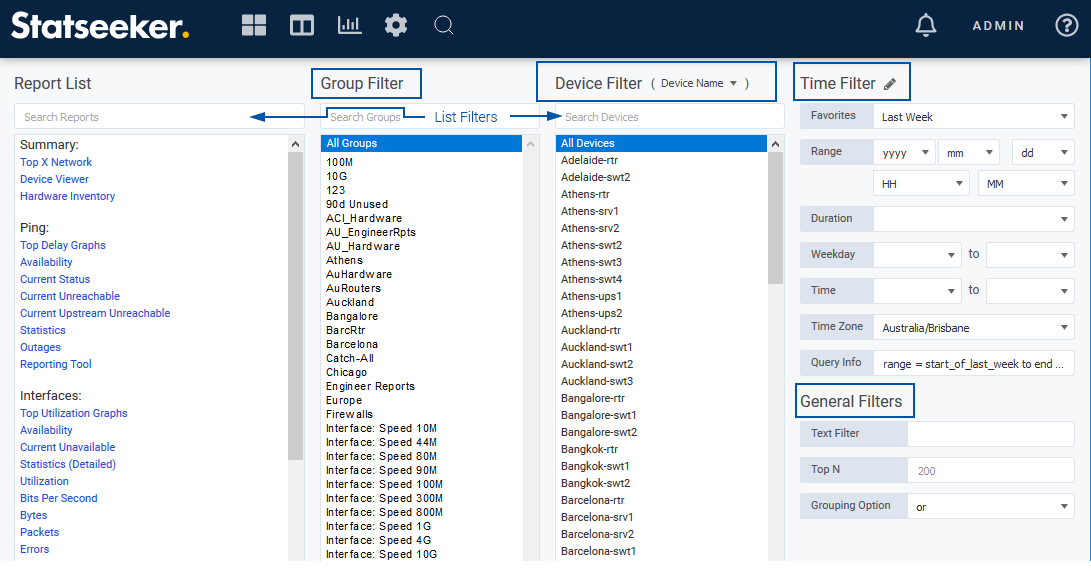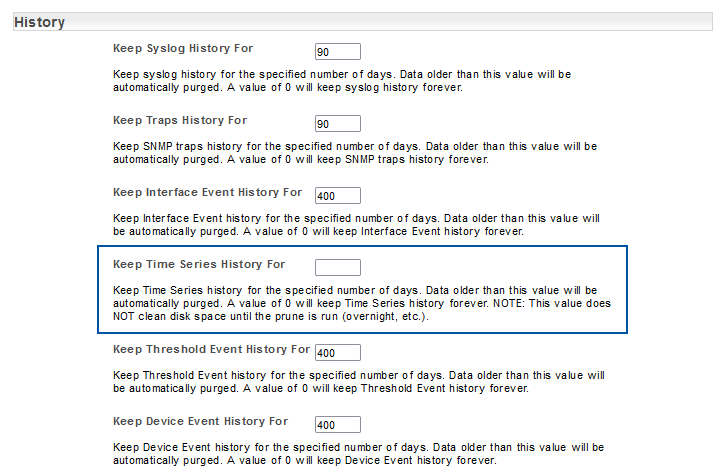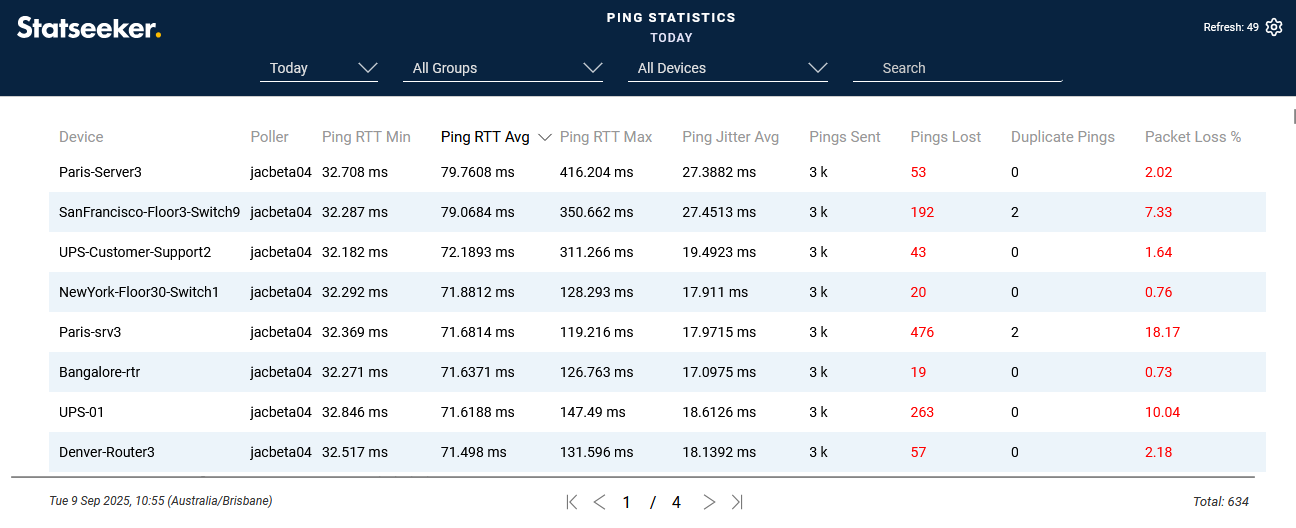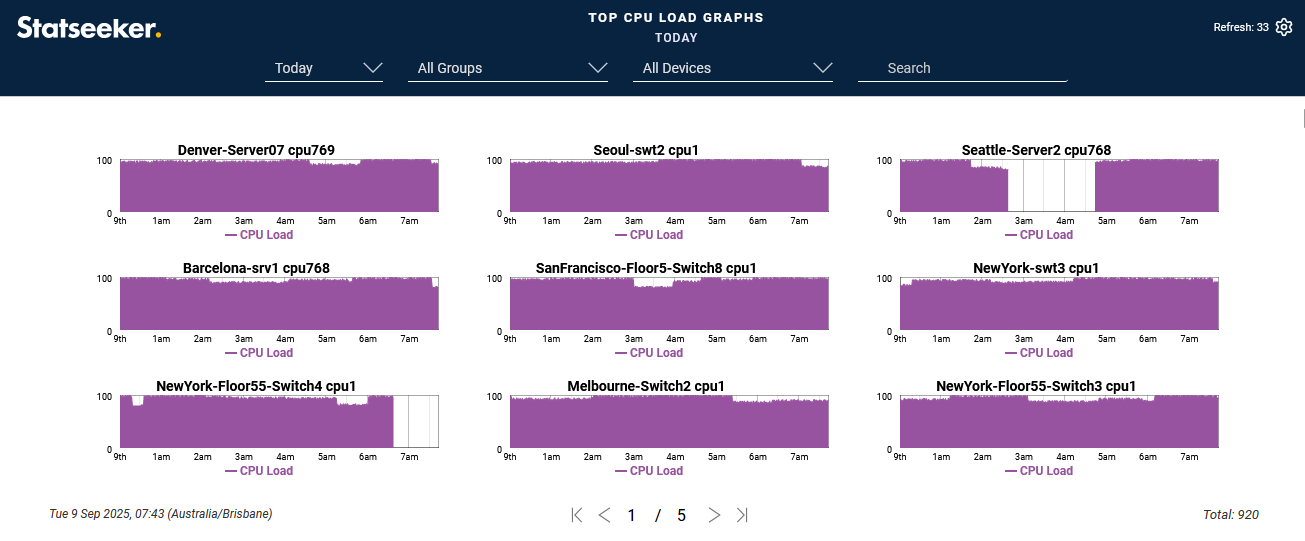Index
- Overview
- Viewing a Report
- Console Report Filters
- Filtering Within Reports
- Report Links, Drill Downs & Historical Views
- Advanced Reporting Tool
- Statseeker Stock Reports
- Vendor and Technology Specific Reports
- Report List
- Managing Availability and Display of Reports
Overview
The Statseeker Console is the primary entryway into the Statseeker reporting functionality. From here you have access to every Statseeker report (pre-packaged or custom made), as well as options and filters to present your data in the way you want.
The Console tailors the stock Report List to reflect those devices/interfaces being polled by Statseeker, filtering out any pre-packaged report that does not apply to your network. The report list is updated as new hardware becomes available on your network, exposing applicable reports that were previously hidden.
Viewing A Report
To view a report from the Console:
- Select any number of groups or devices
- Then select the report to run
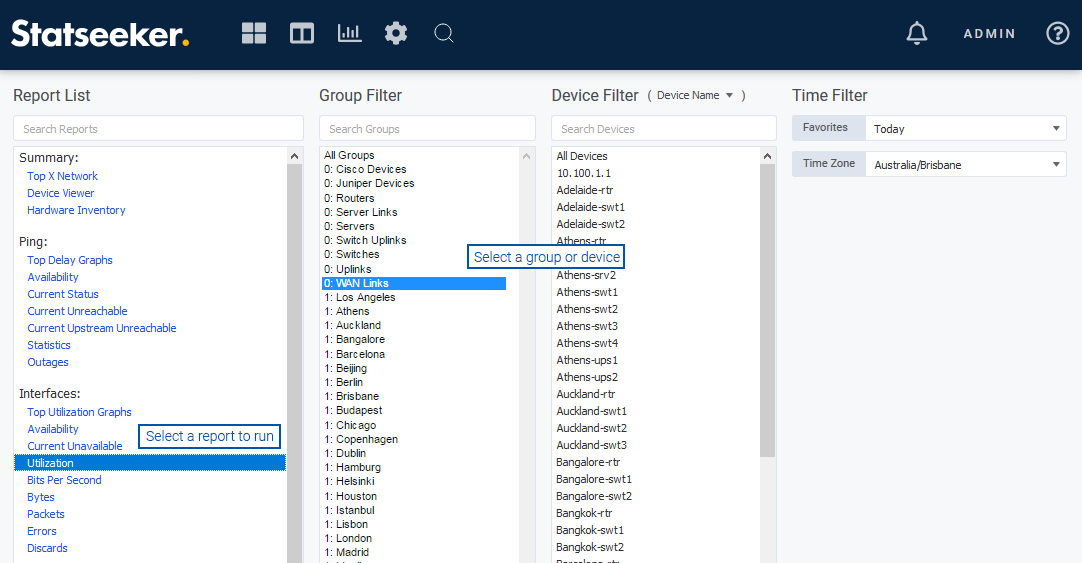
The report will launch in a new window.

Console Report Filters
Reports generally focus upon one or more devices or interfaces and present configuration, event, or timeseries data. The report content can be filtered to better highlight the relevant data using the console filters:
- Group Filter
- Device Filter (can be configured to display and filter against Device Name, IP Address, or sysName)
- Time Filter
- General Filters: Text and Top N
Group and Device Filters
Selecting entries from either the Devices or Groups columns in the console will limit the report content to that selection. These selections are passed through to in-report filters where applicable and may then be further modified within the report.
Not applying Group\Device filters means that the report will request data from your entire network, and this may negatively impact report performance in some instances, depending on the Statseeker server resources.
- Shift + click while clicking to select groups of devices
- Ctrl + click to add/remove a single item to/from the selection
When selecting multiple groups, the General Filters > Grouping Option determines how that selection is processed:
- OR – entities from any of the selected groups
- AND – only entities which appear in all of the selected groups
The displayed content of the Report, Group, and Devices lists can be filtered by entering text in the Search field above each column. In addition, the Device list features a dropdown allowing you to display, and search against, device name, IP address, or sysName.
Time Filter
The Console Time Filter presents a range of options that can be used to specify a reporting period and are applied to:
- Any stock or custom report where the report configuration does not include a specified timefilter. If the report configuration does include a timefilter, then the console timefilter value is ignored when running the report, but typically these reports include in-report timefilter options to update the reporting period from within the report.
- Any legacy ‘event’ based report (legacy reports looking at availability, syslog, SNMP traps, or threshold breaches)
Time Filter Options
- Favorites – a list of pre-configured timefilters, the list can be configured from Administration, see Creating a Time Filter Favorite
- Range and Duration – can be used together to specify a reporting period
- Weekday and Time – can be used together to filter a specified reporting period
- Time Zone – select the timezone for the specified reporting period
- Query Info – the timefilter query that will be used to populate the report (updates as you specify the timefilter but can be manually edited)
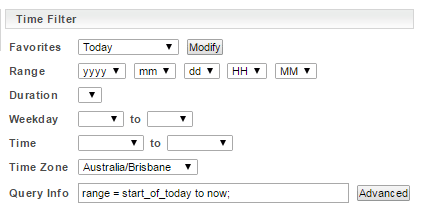
Timeseries Data Retention
Be default, Statseeker stores all timeseries data indefinitely. This default data retention period can be updated from Administration:
- Select Administration > Network Discovery – Advanced Options > Advanced Options
- In the History section, locate the Keep Time Series History For setting and update as needed
- Click Save
General Filters
Text Filter
Enter a string or regex expression to be used in filtering the report content. The supplied filter will be compared to all graph names (typically these are device + entity) in graphical reports, and all device name columns in tabular reports.
Top N
Specifies a limit to the number of results to return.
- The default value is a user-specific setting which can be configured from the edit user screen
- Custom reports can be configured with a specific Results per page setting which will override the user’s Top N setting
Grouping Option
Specify the operator to be applied when making multiple selections in the Group Filter column.
- OR – entities from any of the selected groups
- AND – only entities which appear in all of the selected groups
Filtering Within Reports
Most reports contain filter options within the report header allowing you to assign/modify filters after the report has been launched.

- Any filters applied in the Console prior to running the report are assigned as the default filters used when the report is launched
- If it is a custom report and the configuration specifies filters:
- These will be assigned as the default, overriding the Console filters
- The report header will contain a notification of this override
Time Filter
Most reports feature a Time Filter which can be used to dynamically alter the reporting period of the report while viewing it. When opening a report containing a pre-configured timefilter, the Time Filter defaults to the pre-configured value. When opening a report that does not have a pre-configured timefilter, it defaults to the value specified in the Console. The content of the Time Filter is determined by the server Timefilter Favorites list, which can be modified on a per-user basis, see Timefilter Favorites for details.
By default, reports display the current timefilter in the header (this can be disabled in the report configuration, see Custom Reporting). When using the Time Filter to modify the reporting period, the report header is updated to reflect your selection.
When modifying the reporting period via the Time Filter, the Resolution (interval between plotted data points, and the size of aggregated data ‘buckets’) used in the report is automatically updated to best suit the scope of the report.
For example: on a graph with a reporting period of the previous 3 months, the default interval may be 15 minutes. If the reporting period is updated to the Last 8hrs, then the interval would be updated to 1 minute, giving a granular view more suited to the reporting period. Conversely, using the Time Selector to take a report looking at a single day’s data out to the previous 6 months, might update the interval from 1 minute out to 12 hours. Any slice of that 6 months history can still be viewed at 1-minute resolution when the reporting period is set accordingly.
Group and Device Filters
The Group and Device filters will reflect any group/device selections that were applied in the Console prior to launching the report. This filter selection can be modified to refocus the report while viewing the report.
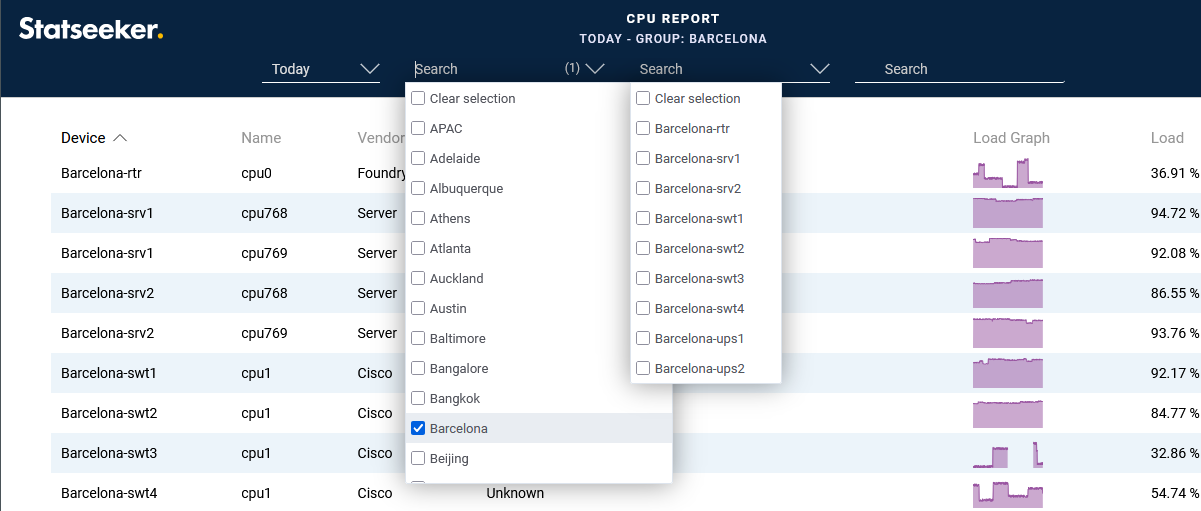
- The Group filter contains all groups on the server that the user has access to, see Managing User Access & Permissions with Grouping
- Group selection determines the content of the in-report Device filter
- Multiple selections can be made in both the Group and Device filters
Text Filter
The Text filter will reflect the content of the General > Text filter that was applied in the Console prior to launching the report. This filter can be modified to refocus the report while viewing the report.

The filter:
- Accepts either a simple string or RegEx
- Matches that string/expression across strings within the report (entity names in graphs, string columns in tables), but not match against timeseries data fields
When a RegExp exclusion filter is applied to tabular reports, the filter is matched against every string/date column in the report, and not against the entire row as a whole. This means that if any filtered column does not contain the exclusion string, the filter is satisfied and the row is displayed, even if other columns do feature the exclusion string.
Report Links, Drill Downs & Historical Views
Most reports will offer the ability to drill-down to more specific data regarding a device, interface, property, or activity presented in the report. In this way you can review a metric across a range of devices, or a range of metrics returned from a single device, identify anomalous values, and then investigate further to resolve the issue as required.
In tabular reports, these drilldowns and pointers to other reports are provided as links on each of the appropriate cell contents, simply click to access the new report.
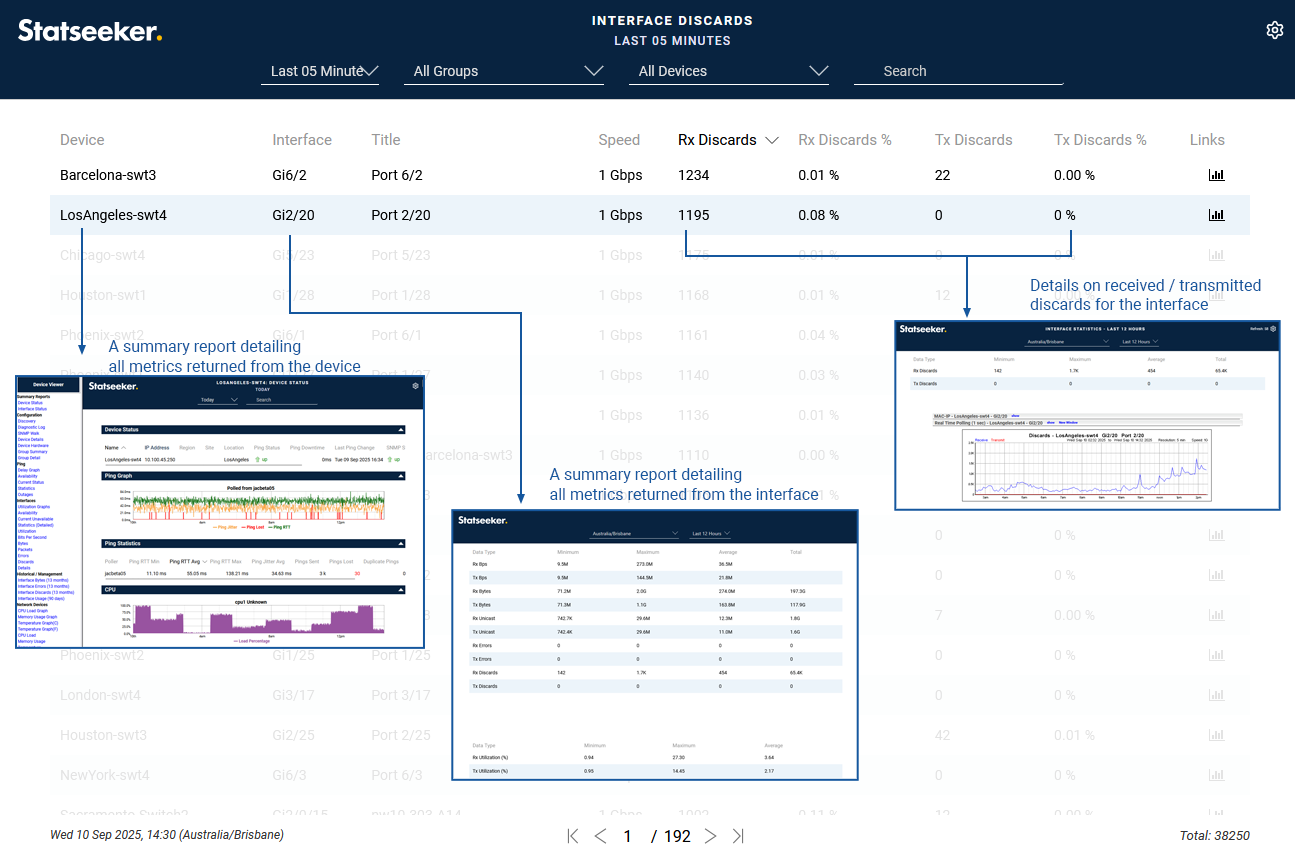
All graph titles act as links to a ‘details’ report for that metric on that device.
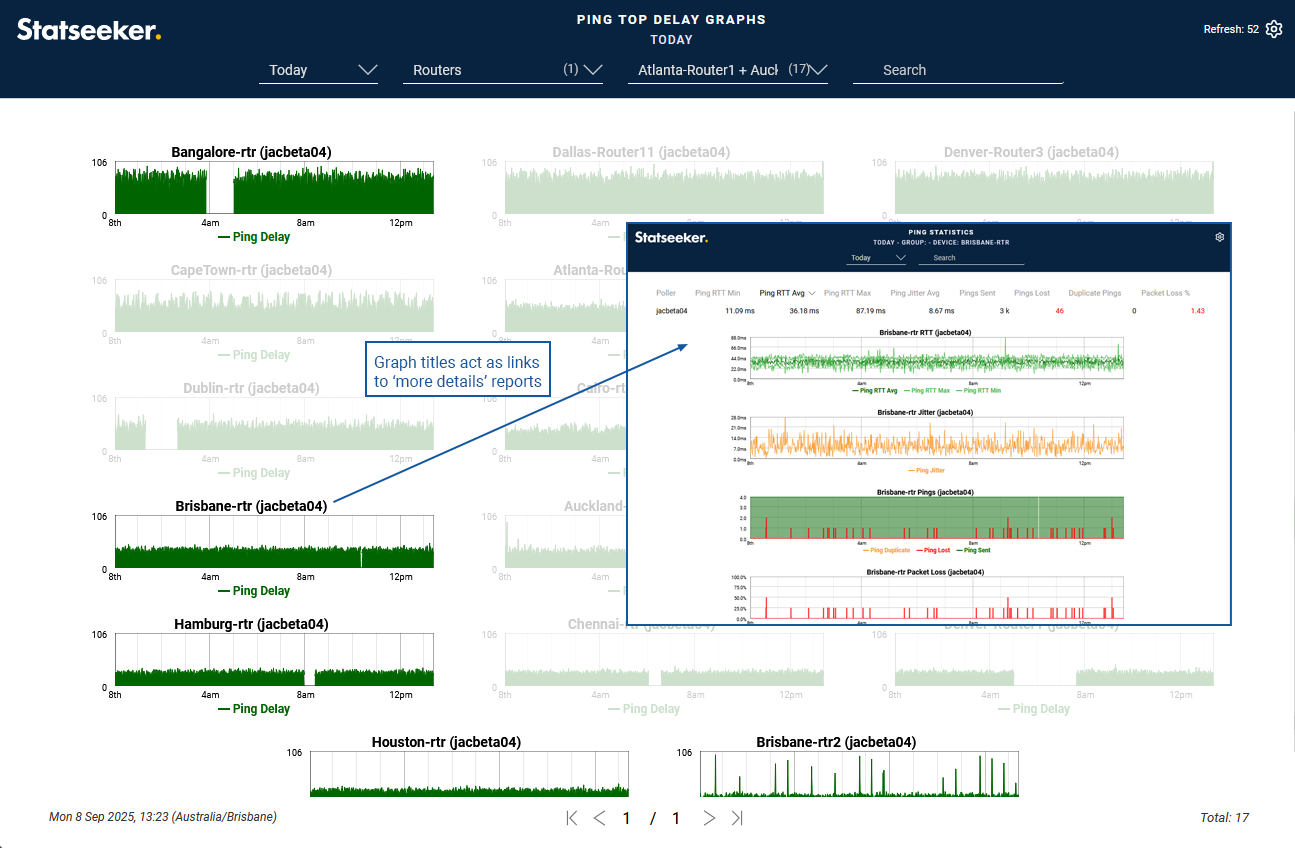
In a similar manner, you can zoom out to review a device or metric over a larger time scale. By default most reports will present what is currently happening, but you can easily alter the report period to ascertain if the current behavior is anomalous or typical.
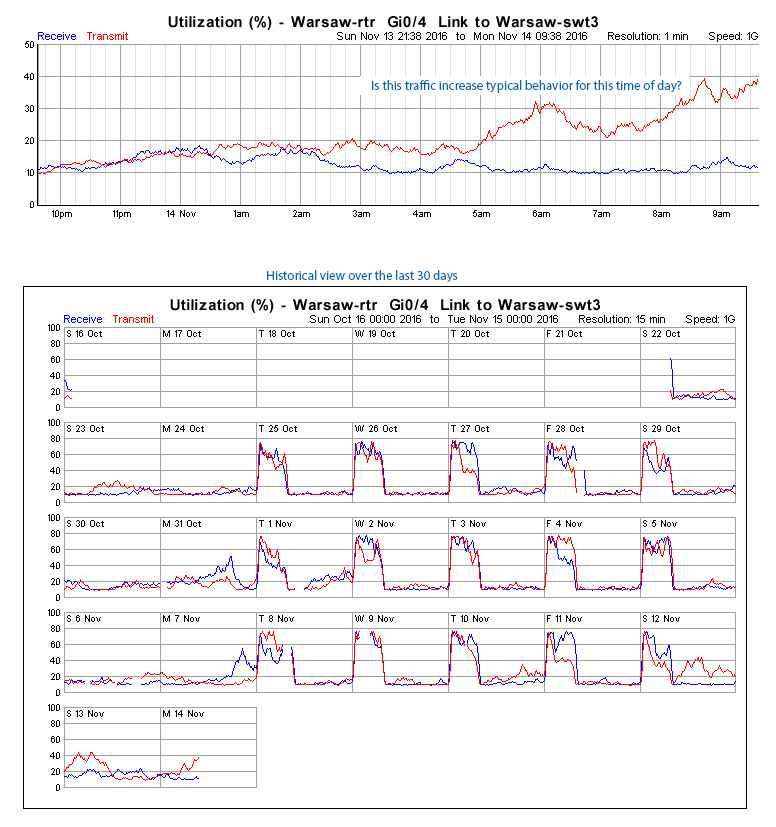
Historical data is available for all devices/interfaces from the moment that they are discovered, and this data is always available at the same 1-minute interval resolution in which it was collected. Statseeker will never ‘roll-up’ (average) your historical data, regardless of how long ago it was collected.
Advanced Reporting Tool
Many of the sections in the Report List feature an entry called Reporting Tool which provides access to additional reporting customization options useful for quickly configuring one-off reports. This feature is also available as a link from within many reports.

The Advanced Reporting Tool breaks available filters and options into 3 groups:
- Time Filter – offering the same options as the console time filter
- General Options – options which vary depending on the focus of the report (server, device, interface, etc.) but can include:
- Report Type – which metric to report on
- Database Type – data manipulation options (display averages, totals, maximums, etc.)
- Interval – resolution of the data
- Aggregate – toggle to select individual or aggregate values
- 95th Percentile – toggle to identify the 95th percentile values for the metric
- Graphing Options – presentation options for graphs
- Graph Type – line, bar, etc.
- Pixels Per Value – how large to display each data point, useful for modifying how bar graphs are presented
- Y Height – modify the y-axis height by the selected % of standard Statseeker graph height
- Y Gridlines – select number of y-axis reference lines to display
- Y Maximum – specify a value and a unit of measurement and only values under that limit will be plotted
- X Gridlines – toggle to display x-axis reference lines
- Legend – display toggle
- Calendar – toggle to wrap the x-axis and remove the requirement for horizontal scrolling when viewing large data sets

The tool allows you to produce tabular reports (using the Report button) or graphical reports (Graph button) and to export (Export button) the report data in *.csv format.
Statseeker Stock Reports
Statseeker is packaged with over 350 stock reports covering all aspects of network monitoring, providing the ability to interrogate and visualize network infrastructure and activity with no requirement for additional report configuration.
By default many of these reports are hidden and only listed once Statseeker discovers a device capable of providing data that would be present in the report. This keeps reporting options focused on the content of your network.
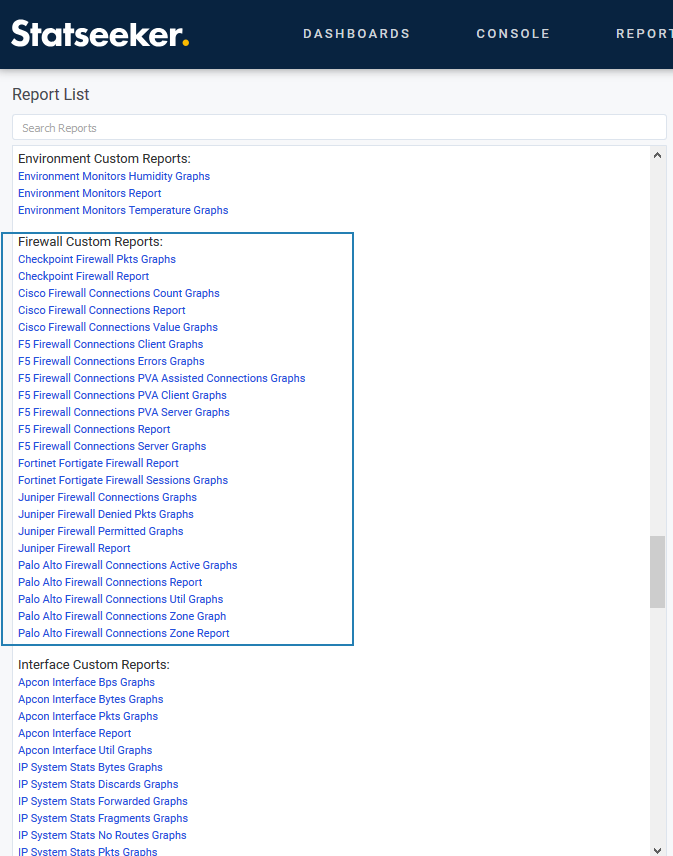
- Select Administration > Network Discovery / Advanced Options > Advanced Options
- Scroll down to the Reports section and:
- to display all reports for all users, set Report Hiding to Off
- to only display all reports to Admin users, set Report Hiding to On and Admin Show All Reports to On
- Click Save
- Return to the Console and refresh the page
Notable Statseeker Reports
An extensive range of reports (420+) are available by default with every Statseeker server deployment. Some notable reports are:
- Summary: Device Viewer
- General: Device Details
- General: Device Hardware Inventory
- Ping: Current Unreachable
- Ping: Statistics
- Interface: Current Unavailable
- Interface: Utilization Baselines
- Network Devices: CPU/Memory/Temperature Reports
Device Viewer
The Device Viewer report is a summary report offering all reports, across all metrics, applicable to the device. The report window is broken into two parts, the left offering a list of all reports for the device and the right which displays the selected report. At launch, the Device Viewer will display the current state and performance for the device. This report also offers the ability to rewalk the device to retrieve any recent changes to the MIB (Management Information Base) for the device.
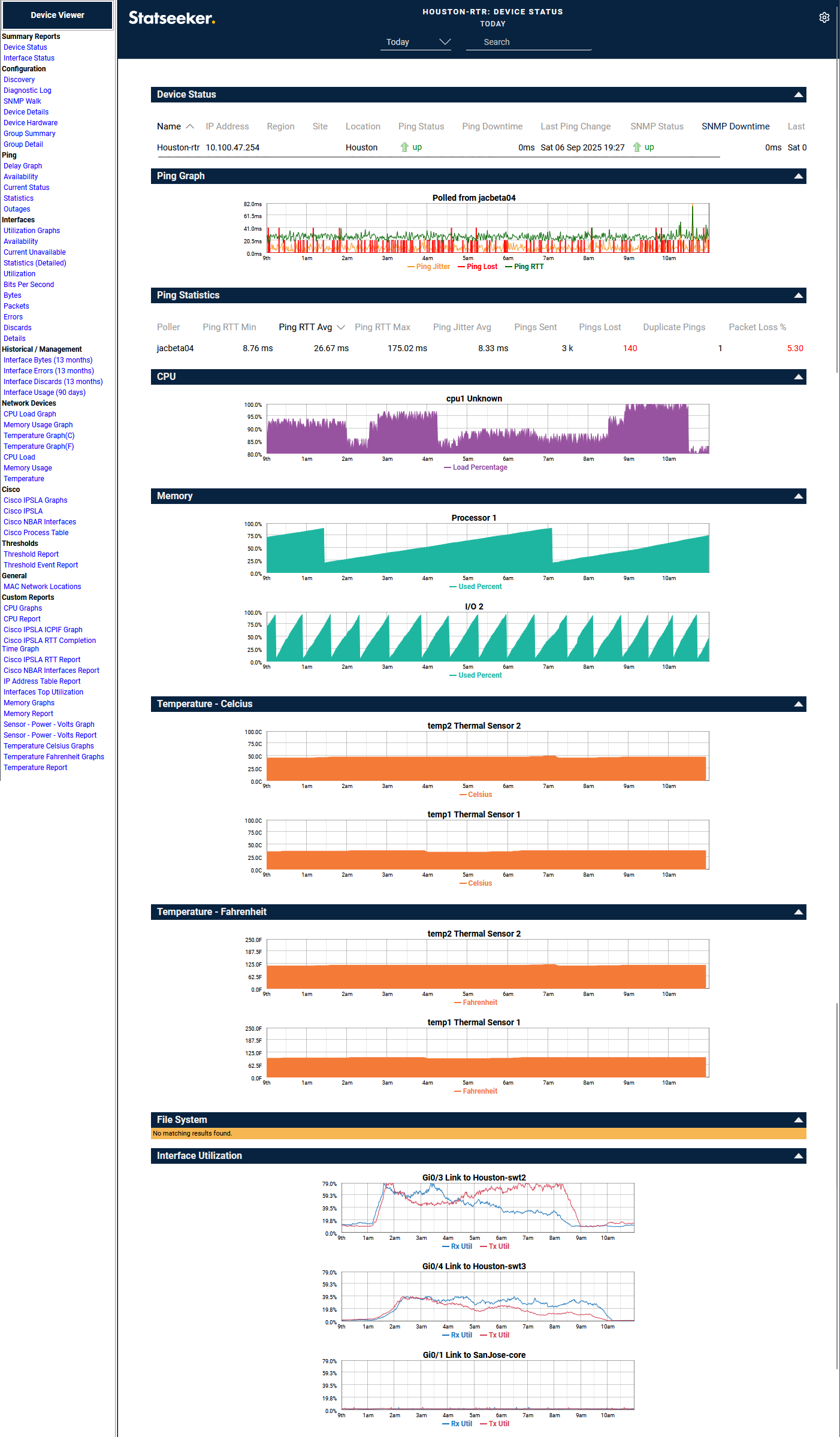
The Device Viewer requires a device to be selected prior to running.
General: Device Details
The General: Device Details report presents configuration details on the selected device/s and provides Admin level users the ability to:
- Toggle both ping and SNMP polling
- Rename the device: edit Device, Hostname or IPAddress, changes will be propagated on next config build (every few minutes)
- Edit SNMP credentials
- Edit latitude, longitude, Region, and Site details
- Edit and lock (preventing subsequent updates from discovery/rewalk processes) the content of the Description (SysDescription) and Location (sysLocation) fields
General: Device Hardware Inventory
The General: Device Hardware Inventory report offers inventory details for the selected devices. These details include:
- Vendor, model, and serial number
- Location
- Software, hardware, and firmware versions
The report also offers links to the Summary Reports > Device Viewer for the selected device.
Ping: Current Unreachable
The Ping: Current Unreachable report details those devices that are currently not returning a ping response. The report offers drilldowns to the Summary Reports > Device Viewer and the Ping Outages reports.
Ping: Statistics
The Ping: Statistics report details minimum, maximum, and average ping response times for devices. The report offers drilldowns to the Summary Reports > Device Viewer and a Ping Response details report.
Interface: Current Unavailable
The Interface: Current Unavailable report details those interfaces that are currently not returning a ping response. The report offers drilldowns to the Summary Reports > Device Viewer and an Interface Outages report.
Interface: Utilization Baselines
The Interface: Utilization Baselines report returns graphical and text-based data on the utilization percentages for interfaces and details on how this behavior compares to historical baseline data for that interface. The default sort is by inbound deviation from historically ‘typical behavior’ and default time period is ‘today’, this time period can be altered from within the report to expand the scope.
The report offers drilldowns to:
- the Device Viewer
- Interface Statistics
- Utilization Baseline Details
- Utilization Trend Details
Network Devices: CPU/Memory/Temperature Reports
Graphical and tabular reports for the major device health metrics of CPU and Memory load and temperature. All reports use a default sort pushing highest load/temperature to the top and feature drilldowns to the Device Viewer.
For a complete list of reports available in a standard Statseeker deployment, see the Report List.
Vendor and Technology Specific Reports
In addition to the more generic reports and the Advanced Reporting Tool, Statseeker offers an extensive range of reports targeting specialist functionality and a wide range of manufacturer-specific network devices, and device configurations.
All of these reports are also available from the Console Report List, and can be added to dashboards, included in their own version of summary reports (See Embedded Reports), and have automated emailing schedules applied. For details on creating your own custom reports see Statseeker Custom Reporting.
These reports (and any custom report that you create, and flag as available from the Console) are automatically grouped according to the report data type and located at the bottom of the Report List in the Console. By default, Statseeker hides from the Console (they are always available from the Reports panel) those reports which don’t apply to any devices currently being monitored on your network. As Statseeker discovers these devices, the corresponding custom reports are displayed in the Console.
- Select Administration > Network Discovery / Advanced Options > Advanced Options
- Scroll down to the Reports section and set Report Hiding to Off
- Click Save
- Return to the Console and refresh the page
Report List
As of Statseeker v25.3, a standard deployment with no additional Custom Data Type (CDT) packages added to the server comes with the following reports available ‘out-of-the-box’:
- Summary:
- Top X Network
- Device Viewer
- Hardware Inventory
- Ping:
- Top Delay Graphs
- Availability
- Current Status
- Current Unreachable
- Current Upstream Unreachable
- Statistics
- Outages
- Reporting Tool
- Current Status (Legacy)
- Current Unreachable (Legacy)
- Statistics (Legacy)
- Top Delay Graphs (Legacy)
- Interfaces:
- Top Utilization Graphs
- Availability
- Current Unavailable
- Statistics (Detailed)
- Statistics (Summary)
- Utilization
- Utilization Baselines
- Utilization Trends
- Bits Per Second
- Bytes
- Packets
- Errors
- Discards
- Details
- Reporting Tool
- Current Unavailable (Legacy)
- Top Utilization Graphs (Legacy)
- General:
- Device Details
- Device Hardware Inventory
- Configuration Details
- MAC-IP Report
- MAC-IP Network Locations
- Traffic Analyzer
- Process Details
- SNMP Availability
- SNMP Outages
- Device Hardware Inventory (Legacy)
- Printers (Legacy)
- Historical / Management:
- Device Group SLA Availability (13 months)
- Device Group SNMP SLA Availability (13 months)
- Interface Group SLA Availability (13 months)
- Interface Bytes (13 months)
- Interface Errors (13 months)
- Interface Discards (13 months)
- Interface Usage (90 days)
- Network Devices:
- Top CPU Load Graphs
- Top Memory Usage Graphs
- Top Temperature Graphs(C)
- Top Temperature Graphs(F)
- CPU Load
- Memory Usage
- Temperature
- Reporting Tool
- Top CPU Load Graphs (Legacy)
- Top Memory Usage Graphs (Legacy)
- Top Temperature Graphs(C) (Legacy)
- Top Temperature Graphs(F) (Legacy)
- Servers:
- Top CPU Load Graphs
- Top Memory Usage Graphs
- CPU Load
- File System Usage
- Memory Usage (Physical)
- Memory Usage (Virtual)
- Reporting Tool
- Top CPU Load Graphs (Legacy)
- Top Memory Usage Graphs (Legacy)
- Events:
- Meraki Network Event Log
- Meraki Security Event Log
- Syslog
- SNMP Traps
- Device Events
- Interface Events
- Thresholds:
- Threshold Summary
- Threshold Report
- Threshold Event Report
- Cisco:
- Top IPSLA Graphs
- IPSLA
- NBAR Interfaces
- Process Table
- Events
- Reporting Tool (IPSLA)
- UPS:
- Battery (Legacy)
- Events (Legacy)
- Input (Legacy)
- Output (Legacy)
- Reporting Tool (Legacy)
- APC:
- Events (Legacy)
- Reporting Tool (Legacy)
- UPS Battery (Legacy)
- UPS Input (Legacy)
- UPS Output (Legacy)
- Frame Relay:
- Details (Legacy)
- Reporting Tool (Legacy)
- Statistics (Legacy)
- Top Utilization Graphs (Legacy)
- Custom Reports:
- Microsoft – DHCP – Usage Graphs
- ACI Custom Reports:
- ACI Application Health Graphs
- ACI Bridging Domain Details
- ACI Bridging Domain Health Graphs
- ACI Bridging Domain Subnet Details
- ACI Client Endpoint Details
- ACI Fault Domain Summary
- ACI Fault Type Summary
- ACI Faults
- ACI Health Graphs
- ACI Node Details
- ACI Node Health Graphs
- ACI Pod Health Graphs
- ACI Private Network Details
- ACI Private Network Health Graphs
- ACI RS Client Endpoint to Path Endpoint
- ACI Tenant Health Graphs
- APIC Application Profiles Graphs
- APIC Bridging Domains Graphs
- APIC Client Endpoints Graphs
- APIC Controllers Graphs
- APIC Details
- APIC Endpoint Groups Graphs
- APIC Leaves Graphs
- APIC Pods Graphs
- APIC Private Networks Graphs
- APIC Spines Graphs
- APIC Tenants Graphs
- Application Custom Reports:
- Cisco NBAR Bits Per Second Graph
- Cisco NBAR Bytes Graph
- Cisco NBAR Interfaces Report
- Cisco NBAR Packets Graph
- Cisco NBAR Report
- Cisco NBAR Util Graph
- EIP DHCP Graphs
- EIP DHCP Report
- EIP DHCP Stats
- EIP DNS Graphs
- EIP DNS Report
- EIP DNS Stats
- Infoblox – DHCP Stats
- Infoblox – DHCP Stats Graphs
- Infoblox – DHCP Usage
- Infoblox – DHCP Usage Graphs
- Infoblox – DNS – Zone Stats Graphs
- Infoblox – DNS – Zones
- Infoblox – DNS HitRate Graph
- Infoblox – DNS Query per Sec Graphs
- Infoblox – DNS Stats
- Infoblox – DNS Zone Transfers Graphs
- Microsoft – DHCP – Current Usage
- Microsoft – DHCP Stats
- Microsoft – DHCP Stats – Graphs
- Asset Custom Reports:
- Hardware Inventory Report
- Inventory Dell DNOS
- Device Health Custom Reports:
- Blue Coat – Proxy Client Connections Graphs
- Blue Coat – Proxy Clients Bps Graphs
- Blue Coat – Proxy Clients Bytes Graphs
- Blue Coat – Proxy Clients Report
- CPU – UCD Table Report
- CPU Graphs
- CPU Idle – UCD Graph Report
- CPU Interrupt – UCD Graph Report
- CPU Kernel – UCD Graph Report
- CPU Load – UCD Graph Report
- CPU Nice – UCD Graph Report
- CPU Report
- CPU System – UCD Graph Report
- CPU User – UCD Graph Report
- Cisco FRU Module OperStatus Report
- Cisco Fan Status Report
- Cisco TCAM Graphs
- Cisco TCAM Summary Report
- Cisco WSA Bandwidth Graphs
- Cisco WSA Bandwidth Report
- Cisco WSA Connections Graphs
- Cisco WSA Hit Rate Graphs
- Cisco WSA Response Time Graphs
- File System Graphs
- File System Report
- Host Resources Report
- Memory Graphs
- Memory Report
- Number of Users Graph
- Power Supply State
- Sensor – Fan Graph
- Sensor – Fan Report
- Sensor – Other Graph
- Sensor – Other Report
- System Processes Graph
- Temperature Celsius Graphs
- Temperature Fahrenheit Graphs
- Temperature Report
- Embedded Custom Reports:
- ACI Summary
- APIC Summary
- Cisco NBAR Graphs
- Cisco WSA Embedded Report
- Device Health Viewer
- EIP DHCP Drilldown Report
- EIP DNS Drilldown Report
- Environment Custom Reports:
- Environment Monitors Dew Point Graphs
- Environment Monitors Humidity Graphs
- Environment Monitors Report
- Environment Monitors Temperature Graphs
- Firewall Custom Reports:
- Checkpoint Firewall Connections Graph
- Checkpoint Firewall Pkts Graphs
- Checkpoint Firewall Report
- Cisco Firewall Connections Count Graphs
- Cisco Firewall Connections Report
- Cisco Firewall Connections Value Graphs
- Cisco WSA Cache Report
- Cisco WSA Connections Report
- Cisco WSA Hit Rate Report
- Cisco WSA Response Time Report
- F5 Firewall Connections Client Graphs
- F5 Firewall Connections Errors Graphs
- F5 Firewall Connections PVA Assisted Connections Graphs
- F5 Firewall Connections PVA Client Graphs
- F5 Firewall Connections PVA Server Graphs
- F5 Firewall Connections Report
- F5 Firewall Connections Server Graphs
- F5 SSL Connections Graph
- Fortinet Fortigate Firewall Report
- Fortinet Fortigate Firewall Sessions Graphs
- Juniper Firewall Connections Graphs
- Juniper Firewall Denied Pkts Graphs
- Juniper Firewall Permitted Graphs
- Juniper Firewall Report
- Palo Alto Firewall Connections Active Graphs
- Palo Alto Firewall Connections Report
- Palo Alto Firewall Connections Util Graphs
- Palo Alto Firewall Connections Zone Graph
- Palo Alto Firewall Connections Zone Report
- HA Custom Reports:
- Palo Alto HA Status Report
- Interface Custom Reports:
- Apcon Interface Bps Graphs
- Apcon Interface Bytes Graphs
- Apcon Interface Pkts Graphs
- Apcon Interface Report
- Apcon Interface Util Graphs
- Cisco IF Extension Graphs
- Cisco IF Extension Report
- Cisco Stack Member Status
- F5 Big IP Bytes Graph
- F5 Big IP Collision Graph
- F5 Big IP Drops Graph
- F5 Big IP Errors Graph
- F5 Big IP Mcast Graph
- F5 Big IP Monitoring Report
- F5 Big IP Packets Graph
- IP System Stats Bytes Graphs
- IP System Stats Discards Graphs
- IP System Stats Forwarded Graphs
- IP System Stats Fragments Graphs
- IP System Stats No Routes Graphs
- IP System Stats Pkts Graphs
- IP System Stats Reassembly Graphs
- IP System Stats Report
- IP System Stats Rx Delivers Graphs
- IP System Stats Rx Errors Graphs
- IP System Stats Tx Requests Graphs
- Interface EtherLike Graphs
- Interface EtherLike Report
- Optical Signal Monitoring – ADVA Graph
- Optical Signal Monitoring – ADVA Report
- Optical Signal Monitoring – Aruba Report
- Optical Signal Monitoring – Hirschmann Report
- Optical Signal Monitoring – Hirschmann2 Report
- Optical Signal Monitoring – Hirschmann2 Temperature (C) Graphs
- Optical Signal Monitoring – NBS Graph
- Optical Signal Monitoring – NBS Report
- Optical Signal Monitoring – Smart Optics Report
- Optical Signal Monitoring Temperature (F) Graph
- Optical Signal Power (dBm) Graphs
- Optical Signal Power (uW) Graphs
- Optical Signal Power Report
- Port Channel Member Status
- Sensor – Optical – Cisco Report
- Sensor – Optical – Cisco dBm Graph
- Sensor – Optical – Cisco mW Graph
- Load Balancer Custom Reports:
- Alteon Group Octets Graph
- Alteon Group Sessions Graph
- Alteon Group Sessions Report
- Alteon Real Server Octets Graph
- Alteon Real Server Sessions Graph
- Alteon Real Server Sessions Report
- Alteon Virtual Server Octets Graph
- Alteon Virtual Server Sessions Graph
- Alteon Virtual Server Sessions Report
- F5 Load Balancer LTM Pool Active Members Graphs
- F5 Load Balancer LTM Pool Bytes Graphs
- F5 Load Balancer LTM Pool Connections Graphs
- F5 Load Balancer LTM Pool Member Bytes Graphs
- F5 Load Balancer LTM Pool Member Connections Graphs
- F5 Load Balancer LTM Pool Member Packets Graphs
- F5 Load Balancer LTM Pool Member Stats
- F5 Load Balancer LTM Pool Packets Graphs
- F5 Load Balancer LTM Pool Stats
- F5 Load Balancer LTM Virtual Server Bytes Graphs
- F5 Load Balancer LTM Virtual Server Connections Graphs
- F5 Load Balancer LTM Virtual Server Packets Graphs
- F5 Load Balancer LTM Virtual Server Stats
- Power Systems Custom Reports:
- PoE Device – Cisco Stats
- PoE Device Power Graphs
- PoE Device Stats
- PoE Device Usage Threshold Graphs
- PoE Interface – Cisco Power Graphs
- PoE Interface – Cisco Stats
- PoE Interface Invalid Signature Counter Graphs
- PoE Interface Overload Counter Graphs
- PoE Interface Power Denied Counter Graphs
- PoE Interface Short Circuit Counter Graphs
- PoE Interface Stats
- Power Systems – Cordex CXC UPS Graphs
- Power Systems – UPS – Cordex CXC
- Power Systems Battery Remaining Graphs
- Power Systems Battery Report
- Power Systems Battery Report – APC
- Power Systems Input Graph
- Power Systems Input Report
- Power Systems Output Graph
- Power Systems Output Report
- Sensor – Power – Amps Graph
- Sensor – Power – Amps Report
- Sensor – Power – Volts Graph
- Sensor – Power – Volts Report
- Sensor – Power – Watts Graph
- Sensor – Power – Watts Report
- QoS Custom Reports:
- Cisco CB QoS Class Data
- Cisco CB QoS ClassMap Config
- Cisco CB QoS Match BitRate Graphs
- Cisco CB QoS Match Config
- Cisco CB QoS Match Data
- Cisco CB QoS Policy BitRate Graphs
- Cisco CB QoS Policy and Class Config
- Cisco CB QoS PolicyMap Config
- Cisco CB QoS Queue Config
- Cisco CB QoS Queue Data
- Cisco CB QoS Queue Used Graphs
- Juniper CoS Byte Rate Graphs
- Juniper CoS Report
- Juniper CoS Tail Drop Graphs
- Juniper CoS Total Drop Graphs
- Juniper CoS Tx Rate Graphs
- Radio Custom Reports:
- Radio – Aviat Errored Blocks Graph
- Radio – Aviat Metric Graphs
- Radio – Aviat Metrics
- Radio – Aviat Performance
- Remote Service Custom Reports:
- Cisco IPSLA ICPIF Graph
- Cisco IPSLA Jitter Dst to Src Graph
- Cisco IPSLA Jitter Graph
- Cisco IPSLA Jitter Report
- Cisco IPSLA Jitter Src to Dst Graph
- Cisco IPSLA MOS Graph
- Cisco IPSLA RTT Completion Time Graph
- Cisco IPSLA RTT Report
- HH3C – NQA ICPIF Graphs
- HH3C – NQA Jitter Dst to Src Graphs
- HH3C – NQA Jitter Loss Graphs
- HH3C – NQA Jitter Report
- HH3C – NQA Jitter Src to Dst Graphs
- HH3C – NQA MOS Graphs
- Juniper Ping Report
- Juniper Ping Rtt Graphs
- Juniper RPM Graph Report
- Juniper RPM Percent Lost Graphs
- Juniper RPM PkToPk Graphs
- Juniper RPM Report
- SD-WAN Custom Reports:
- SD-WAN – Catalyst BFD Sessions
- SD-WAN – Catalyst BFD Summary
- SD-WAN – Catalyst BFD Summary Graphs
- SD-WAN – Catalyst BFD TLOC
- SD-WAN – Catalyst BFD TLOC Sessions Graphs
- SD-WAN – Catalyst BFD Transitions Graphs
- SD-WAN – Catalyst Connection Count Graphs
- SD-WAN – Catalyst Connections Counts
- SD-WAN – Catalyst Interface Stats
- SD-WAN – Catalyst Interface Stats Bytes
- SD-WAN – Catalyst Interface Stats Drops
- SD-WAN – Catalyst Interface Stats Errors
- SD-WAN – Catalyst Interface Stats Graphs
- SD-WAN – Catalyst Interface Stats Packets
- SD-WAN – Catalyst Interface Stats Pps
- Software Defined Custom Reports:
- 128T Peer Status Report
- Threshold Custom Reports:
- Juniper RPM Thresholds Report
- Topology Custom Reports:
- BGP Peer FSM Established Time Graphs
- BGP Peer FSM Established Transitions Graphs
- BGP Peer Messages Graphs
- BGP Peer Report
- BGP Peer Rx Update Elapsed Time Graphs
- BGP Peer Updates Graphs
- Cisco BGP Peer Prefix Graphs
- Cisco BGP Peer Prefix Report
- Cisco Discovery Protocol Report
- Cisco EIGRP Ack Graphs
- Cisco EIGRP Hello Graphs
- Cisco EIGRP Neighbor Count Graphs
- Cisco EIGRP Peer Report
- Cisco EIGRP Query Graphs
- Cisco EIGRP Reply Graphs
- Cisco EIGRP Retransmission Timeout Graphs
- Cisco EIGRP Retransmit Graphs
- Cisco EIGRP Route Graphs
- Cisco EIGRP SRTT Graphs
- Cisco EIGRP Stats Report
- IP Address Table (Including IPv6) Report
- IP Address Table Report
- OSPF Neighbor Events Graph
- OSPF Neighbor Interfaces Events Graph
- OSPF Neighbor Interfaces Report
- OSPF Neighbors Current Down Report
- OSPF Neighbors Current Status Report
- SD-WAN – VeloCloud Control Bytes Graphs
- SD-WAN – VeloCloud Control Packets Graphs
- SD-WAN – VeloCloud HA State
- SD-WAN – VeloCloud Jitter Graphs
- SD-WAN – VeloCloud Latency Graphs
- SD-WAN – VeloCloud Lost Packets Graphs
- SD-WAN – VeloCloud Priority Bytes Graphs
- SD-WAN – VeloCloud Priority Packets Graphs
- SD-WAN – VeloCloud Statistics
- VPN Custom Reports:
- Checkpoint VPN Active IPsec Tunnels Graphs
- Checkpoint VPN Sessions Errors Graphs
- Checkpoint VPN Sessions Packets Graphs
- Checkpoint VPN Sessions Report
- Checkpoint VPN Sessions User Tunnels Graphs
- Cisco VPN IPSec Active Tunnels Graphs
- Cisco VPN IPSec Global Bytes Graphs
- Cisco VPN IPSec Global Packets Graphs
- Cisco VPN IPSec Global Report
- Cisco VPN IPSec Tunnels Bytes Graphs
- Cisco VPN IPSec Tunnels Packets Graphs
- Cisco VPN IPSec Tunnels Report
- Cisco VPN Profile Users Graphs
- Cisco VPN Profiles Bps Graphs
- Cisco VPN Profiles Octets Graphs
- Cisco VPN Profiles Packets Graphs
- Cisco VPN Profiles Report
- Cisco VPN Sessions Email Graphs
- Cisco VPN Sessions Graphs
- Cisco VPN Sessions IPSec Graphs
- Cisco VPN Sessions LAN to LAN Graphs
- Cisco VPN Sessions Load Balancing Graphs
- Cisco VPN Sessions Report
- Cisco VPN Sessions SVC Sessions Graphs
- Cisco VPN Sessions User Graphs
- Cisco VPN Sessions User Group Graphs
- Cisco VPN Sessions Webvpn Graphs
- Citrix Netscaler AAA Graphs
- Citrix Netscaler AAAATM Graphs
- Citrix Netscaler Auth Graphs
- Citrix Netscaler Authorization Report
- Citrix Netscaler ICA Graphs
- Citrix Netscaler Session Report
- F5 APM Sessions
- F5 APM Sessions Graphs
- Fortinet Fortigate SSL Tunnels Graphs
- Fortinet Fortigate SSL Users Graphs
- Fortinet Fortigate VPN Stats Report
- Fortinet Fortigate Web Sessions Graphs
- Juniper Pulse VPN Graph
- Juniper Pulse VPN Report
- Palo Alto VPN Graph
- Palo Alto VPN Report
- SonicWall VPN Users Graph
- SonicWall VPN Users Report
- Voice Custom Reports:
- Cisco Active DS0 Report
- Cisco Active DS0s Graphs
- Cisco Call Stats Calls Graphs
- Cisco Call Stats Report
- Cisco Call Stats Total Active Connections Graphs
- WAN Custom Reports:
- Cisco APPNAV Report
- Cisco WAAS Graphs
- Cisco WAAS Report
- Riverbed WAN Accelerator Bandwidth Optimization Bps Graphs
- Riverbed WAN Accelerator Bandwidth Optimization Bps Report
- Riverbed WAN Accelerator Graphs
- Riverbed WAN Accelerator Report
- Wireless Custom Reports:
- Cisco WAN 3G Bytes Graphs
- Cisco WAN 3G EcIo Graphs
- Cisco WAN 3G Nearby Cells Report
- Cisco WAN 3G RSSI Graphs
- Cisco WAN 3G Report
- Cisco WAN 3G Retries Remaining Graphs
- Cisco WAN 3G Temperature Graphs
- Cisco WAN 4G RSRP Graphs
- Cisco WAN 4G RSRQ Graphs
- Cisco WAN 4G Report
- Cisco WAN 4G SINR Graphs
- Cisco WAN 4G SNR Graphs
- Ubiquiti AirMAX Graphs
- Ubiquiti AirMAX Report
- Ubiquiti Radio Report
- Ubiquiti Stations Bps Graphs
- Ubiquiti Stations Report
- Ubiquiti Stations Signal Graphs
- Ubiquiti Wireless Statistics Bps Graphs
- Ubiquiti Wireless Statistics CCQ Graphs
- Ubiquiti Wireless Statistics RSSI Graphs
- Ubiquiti Wireless Statistics Report
- Ubiquiti Wireless Statistics Signal Strength Graphs
- WLC – Cisco AP CDP Neighbors
- WLC – Cisco AP Client Count Graphs
- WLC – Cisco AP Events
- WLC – Cisco AP Interface Events
- WLC – Cisco AP Interface Status
- WLC – Cisco AP Inventory
- WLC – Cisco SSID Users
- WLC – Cisco SSID Users Graph
- Wireless AP Cisco Graph
- Wireless AP Cisco Report
- Wireless AP Client Count Graph
- Wireless AP Report
Managing Availability and Display of Reports
There are a couple of factors which determine the visibility of reports:
- Global report settings
- User-specific report visibility settings
Global Report Settings
Administration contains settings which impact the visibility of MAC-IP and Inventory reports, unused reports, and the real-time interface poller.
These settings can be reviewed and updated altered as needed:
- Select Administration > Network Discovery – Advanced Options > Advanced Options
- Locate the settings in the Reporting section and update as needed
- Click Save
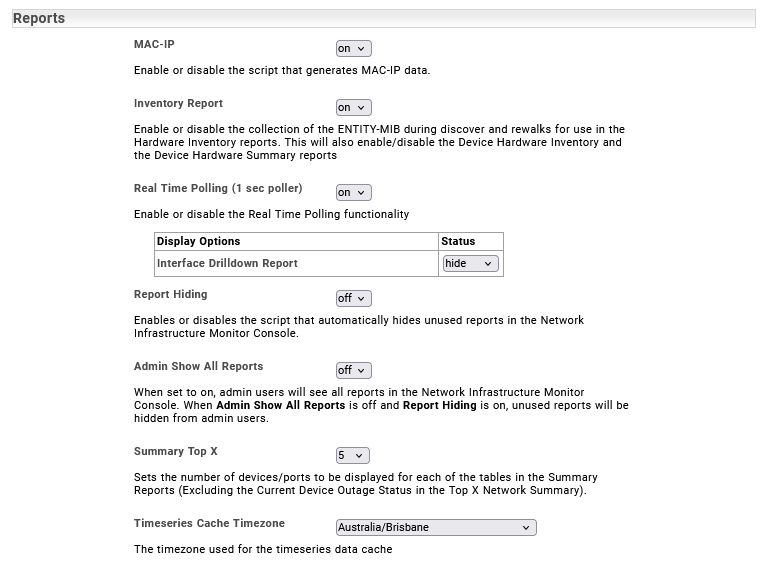
User-specific Report Visibility
By default a new Statseeker user account has no visibility of your network via Statseeker. To allow the user to access reports and view data collected from your network you need to associate the user account with one or more groups containing network infrastructure and reports. For more details on this process see Managing User Access & Permissions with Grouping.

